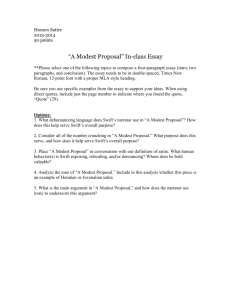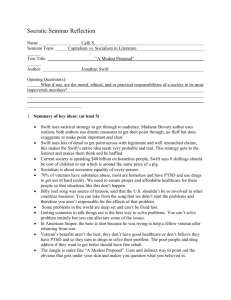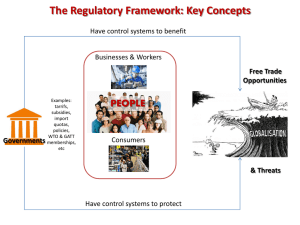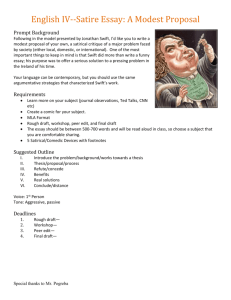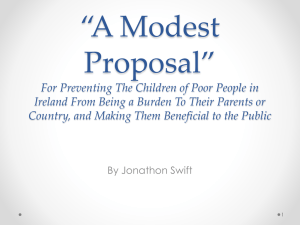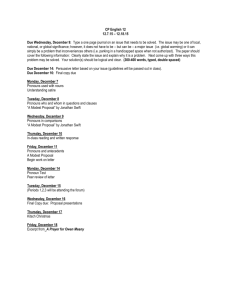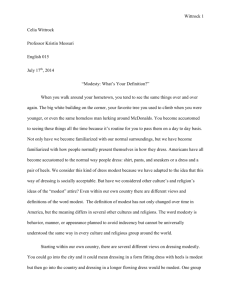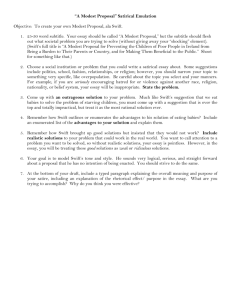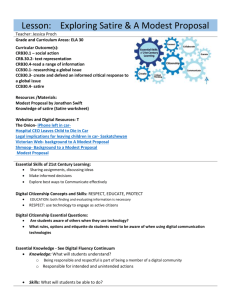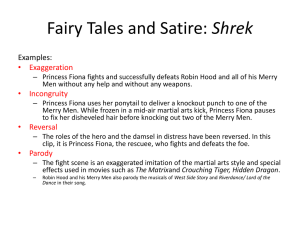Student Profile
advertisement
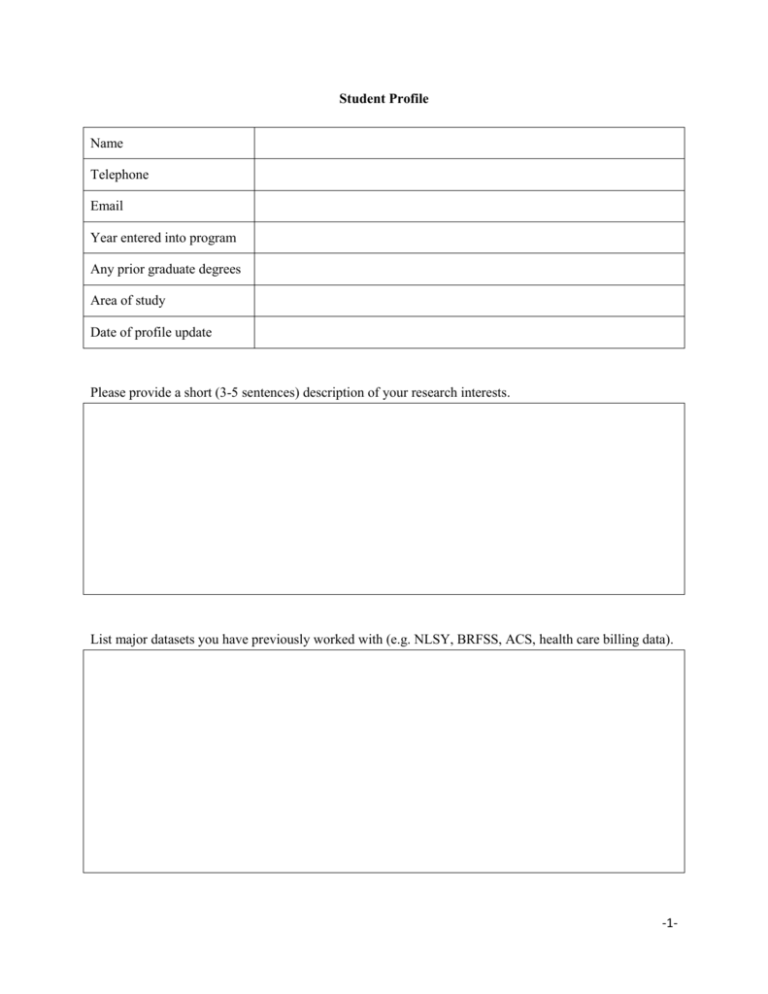
Student Profile Name Telephone Email Year entered into program Any prior graduate degrees Area of study Date of profile update Please provide a short (3-5 sentences) description of your research interests. List major datasets you have previously worked with (e.g. NLSY, BRFSS, ACS, health care billing data). -1- Briefly describe past research experience. Briefly describe academic research papers, technical reports, and other professional writing you have completed. For coauthored work, explain your specific writing contributions (e.g. preparing tables). -2- Briefly describe professional presentation experience, such as preparing and presenting conference posters, preparing and delivering research presentations with and/or without PowerPoint, type of audience, and length of presentations. Evaluate your proficiency and level of experience in the research skills below. This list covers a wide range of skills, from those that are very common in research to those that are highly specialized and idiosyncratic. You should expect to leave many of these potential skills unchecked, and do not be demoralized if you check a small number of items. All of the faculty would leave many of these skills unchecked—although each faculty member would check different rows. In the first column (ANY), check “yes” if you have any proficiency. Leave it blank if not. In the right column (LEVEL OF EXPERIENCE), rate your proficiency from “high proficiency” (you have used this technique extensively in independent research), “medium proficiency” (you have used this technique in a class and would feel comfortable doing this if you had modest guidance from a senior researcher or project manager, and time to review textbooks or other tutorials), or “modest proficiency” (you have encountered this in a class or through reading articles and books and are willing to invest time to learn the skill, but you need guidance). To maintain the formatting and make it easy for faculty and researchers to read, replace the “” with “X” in Word. See the example below: Quantitative Data Collection Skills X Yes Survey design X Yes Finding secondary datasets and converting them into a usable format for statistical software X Yes Coding primary documents to make quantitative datasets (e.g. media articles, contracts, policy documents) Administering lab experiments Yes Administering quantitative surveys Yes X Yes Entering quantitative survey data high medium X modest high X medium modest X high medium modest high medium modest high medium modest X high medium modest -3- ANY SKILL Computer Software Skills for Quantitative Analysis Stata Yes - Opening datasets and writing basic do files - Organizing data (e.g. merging files, reshaping files) - Cleaning data (e.g. recoding variables, looking for missing data and inconsistencies) - Graphing - Post-estimation commands (e.g. generating predicted values) - Writing macros or functions SAS Yes - Opening datasets and writing basic syntax - Organizing data (e.g. merging files, reshaping files) - Cleaning data (e.g. recoding variables, looking for missing data and inconsistencies) - Graphing - Post-estimation commands (e.g. generating predicted values) - Writing macros or functions SPSS Yes - Opening datasets and writing basic syntax files - Organizing data (e.g. merging files, reshaping files) - Cleaning data (e.g. recoding variables, looking for missing data and inconsistencies) - Graphing - Post-estimation commands (e.g. generating predicted values) - Writing macros or functions R Yes - Opening datasets and writing basic syntax files - Organizing data (e.g. merging files, reshaping files) - Cleaning data (e.g. recoding variables, looking for missing data and inconsistencies) - Graphing - Post-estimation commands (e.g. generating predicted values) - Writing macros or functions Other statistical software: Yes ArcGIS Yes Visual Basic Yes Vensim Yes Other simulation software: Yes TreeAge or other decision analysis software Yes Access Yes Excel Yes - Basic formulas using absolute and relative cell references - Tables - Charts - Pivot tables - Sorting data (e.g. filtering) Quantitative Data Analysis Skills Simple descriptive statistics (e.g. means, proportions) Yes Using graphics for visual exploratory data analysis (e.g. examining Yes skewed distributions, outliers) OLS regression Yes LEVEL OF EXPERIENCE high medium modest high medium modest high medium modest high medium modest high medium modest high medium modest high medium modest high medium modest high medium modest high medium modest high medium modest high medium modest high medium modest high medium modest high medium modest high medium modest high medium modest high medium modest high medium modest high medium modest high medium modest high high high high high high high high high high medium medium medium medium medium medium medium medium medium medium modest modest modest modest modest modest modest modest modest modest high high high high high medium medium medium medium medium modest modest modest modest modest high medium modest high medium modest high medium modest -4- Yes Yes Logit/probit regression Regression for count data (e.g. Poisson, negative binomial, zeroinflated negative binomial) Tobit/Heckit regression Yes Analyzing experimental data (e.g. ANOVA, ANCOVA) Yes Multivariate statistics (e.g. factor analysis, MANOVA, structural Yes equations modeling) Survival analysis (e.g. proportional hazards models, survival curves) Yes Time series analysis Yes Analyzing complex survey data (e.g. using sampling weights) Yes Differences in differences Yes Resampling standard errors (e.g. bootstrap, jackknife) Yes Multiple imputation for missing data Yes Instrumental variables Yes Forecasting Yes Using panel data (e.g. fixed effects, random effects) Yes Other statistical techniques: Yes Quantitative Data Collection Skills Survey design Yes Finding secondary datasets and converting them into a usable format Yes for statistical software Coding primary documents to make quantitative datasets (e.g. media Yes articles, contracts, policy documents) Administering lab experiments Yes Administering quantitative surveys Yes Entering quantitative survey data Yes Qualitative Data Collection and Analysis Skills Collecting data in the following ways (check all that apply): Yes interviews focus groups locating primary documents observation (participant or non-participant) Exposure to the following methodologies (check all that apply): Yes ethnography grounded theory action research case studies comparative case studies discourse analysis Boolean analysis Exposure to any of the following theoretical perspectives (check all Yes that apply) symbolic interactionism phenomenology hermeneutics critical theory postmodernism Transcribing interviews and focus groups Yes Coding data using Atlas.ti Yes Coding data using NVivo Yes Coding data using other qualitative software: Yes Literature Review and Document Searching Skills Locate statutes, regulations, and other policy documents Yes Locate academic articles Yes Conduct a systematic literature review Yes Summarize academic and non-academic literature for a lay audience Yes (describe fields where you feel comfortable doing this) Yes Yes Organize references in EndNote Other reference manager software (e.g. Zotero): high medium modest high medium modest high medium modest high medium modest high medium modest high high high high high high high high high high medium medium medium medium medium medium medium medium medium medium modest modest modest modest modest modest modest modest modest modest high medium modest high medium modest high medium modest high medium modest high medium modest high medium modest high medium modest high medium modest high medium modest high high high high medium medium medium medium modest modest modest modest high high high high medium medium medium medium modest modest modest modest high medium modest high medium modest -5- Project Management and Coordination Skills Project management roles (check all that apply): Yes developed timelines assigned tasks to research assistants supervised students track budgets and spending prepare reports to sponsors Project coordination roles (check all that apply): Yes organized meetings organized conferences organized seminars prepare meeting agendas and minutes other organizational roles: Human subjects research IRB applications (check all that apply): Yes prepared IRB application drafted informed consent statement Other Skills Not Listed Above Briefly describe any other research skills not covered above: Yes high medium modest high medium modest high medium modest high medium modest -6- SAMPLE Name Rocky Feller Telephone 518-123-4567 Email rfeller@albany.edu Year entered into program 2010 Any prior graduate degrees MA in political science Area of study Public Policy Date of profile update May 7, 2013 Please provide a short (3-5 sentences) description of your research interests. I am interested in human services policies, including health policy and education policy. My dissertation will use GIS modeling to evaluate how physical proximity to disco clubs is related to health outcomes, and the political factors associated with local ordinances on disco club restrictions. Outside my dissertation, I am interested in how the SUNY 2020 program will affect access to graduate scholarships and graduation rates. List major datasets you have previously worked with (e.g. NLSY, BRFSS, ACS, health care billing data). I have worked with the TIGER/Line shapefiles from the US Census Bureau, the Behavioral Risk Factor Surveillance System (BRFSS) from the CDC, and administrative admissions data from UAlbany -7- Briefly describe past research experience. Prior to coming to UAlbany, I worked with Professor Remus Lupin at Syracuse on a project to evaluate werewolves’ integration into New York society. I conducted semi-structured interviews with 36 Upstate werewolves and assisted Professor Lupin with coding the data in Atlas.ti software. As a follow-up project, I administered mail and telephone surveys about public perceptions about werewolves to Syracuse parents. I was responsible for organizing the mailing, including reminder postcards and collecting the survey instruments. I contacted non-responders by telephone. I also entered all of the data using a scanner, and did simple descriptive statistics (means and percentages) in SPSS. Briefly describe academic research papers, technical reports, and other professional writing you have completed. For coauthored work, explain your specific writing contributions (e.g. preparing tables). My literature review paper is in the revise & resubmit stage at Disco Quarterly. It is coauthored with my adviser but I took the lead in drafting it and preparing all of the tables. When I first started my PhD program, I had a research assistant assignment with Professor Plum. I assisted him with his manuscript about the similarities of apples and oranges. Under his guidance, I located relevant academic literature and organized the studies into an Excel sheet so that he could more easily see what had already been published on the topic. Professor Plum handed me a large document with his Stata output, and I was in charge of turning the Stata output into tables that were suitable for publication. Finally, I did a community outreach project with a local disco club and put together a 2-page fact sheet for them about how discoing can improve personal health and increase longevity. -8- Briefly describe professional presentation experience, such as preparing and presenting conference posters, preparing and delivering research presentations with and/or without PowerPoint, type of audience, and length of presentations. I have been to APPAM a couple of times, although I only had a poster presentation and not a podium presentation. I prepared the posters. However, I have had a lot of speaking experience as a PAD 504 instructor for the past two years. I rely on both PowerPoint slides as well as doing hands-on lab tutorials and some white board-based discussions. I have also led a few information sessions on the health effects of discos for the lay public in Albany. Evaluate your proficiency and level of experience in the research skills below. This list covers a wide range of skills, from those that are very common in research to those that are highly specialized and idiosyncratic. You should expect to leave many of these potential skills unchecked, and do not be demoralized if you check a small number of items. All of the faculty would leave many of these skills unchecked—although each faculty member would check different rows. In the first column (ANY), check “yes” if you have any proficiency. Leave it blank if not. In the right column (LEVEL OF EXPERIENCE), rate your proficiency from “high proficiency” (you have used this technique extensively in independent research), “medium proficiency” (you have used this technique in a class and would feel comfortable doing this if you had modest guidance from a senior researcher or project manager, and time to review textbooks or other tutorials), or “modest proficiency” (you have encountered this in a class or through reading articles and books and are willing to invest time to learn the skill, but you need guidance). To maintain the formatting and make it easy for faculty and researchers to read, replace the “” with “X” in Word. See the example below: Quantitative Data Collection Skills X Yes Survey design X Yes Finding secondary datasets and converting them into a usable format for statistical software X Yes Coding primary documents to make quantitative datasets (e.g. media articles, contracts, policy documents) Administering lab experiments Yes Administering quantitative surveys Yes X Yes Entering quantitative survey data high medium X modest high X medium modest X high medium modest high medium modest high medium modest X high medium modest -9- ANY SKILL Computer Software Skills for Quantitative Analysis X Yes Stata - Opening datasets and writing basic do files - Organizing data (e.g. merging files, reshaping files) - Cleaning data (e.g. recoding variables, looking for missing data and inconsistencies) - Graphing - Post-estimation commands (e.g. generating predicted values) - Writing macros or functions SAS Yes - Opening datasets and writing basic syntax - Organizing data (e.g. merging files, reshaping files) - Cleaning data (e.g. recoding variables, looking for missing data and inconsistencies) - Graphing - Post-estimation commands (e.g. generating predicted values) - Writing macros or functions X Yes SPSS - Opening datasets and writing basic syntax files - Organizing data (e.g. merging files, reshaping files) - Cleaning data (e.g. recoding variables, looking for missing data and inconsistencies) - Graphing - Post-estimation commands (e.g. generating predicted values) - Writing macros or functions R Yes - Opening datasets and writing basic syntax files - Organizing data (e.g. merging files, reshaping files) - Cleaning data (e.g. recoding variables, looking for missing data and inconsistencies) - Graphing - Post-estimation commands (e.g. generating predicted values) - Writing macros or functions Other statistical software: Yes X Yes ArcGIS Visual Basic Yes Vensim Yes Other simulation software: Yes TreeAge or other decision analysis software Yes Access Yes X Yes Excel - Basic formulas using absolute and relative cell references - Tables - Charts - Pivot tables - Sorting data (e.g. filtering) Quantitative Data Analysis Skills X Yes Simple descriptive statistics (e.g. means, proportions) X Yes Using graphics for visual exploratory data analysis (e.g. examining skewed distributions, outliers) X Yes OLS regression LEVEL OF EXPERIENCE high X medium modest high X medium modest high X medium modest high X medium modest high medium X modest high medium modest high medium modest high medium modest high medium modest high medium modest high medium modest high medium modest X high medium modest high X medium modest X high medium modest high medium modest high medium modest high medium X modest high medium modest high medium modest high medium modest high high high X high high high high high high high medium medium medium medium medium medium medium medium medium medium modest modest modest modest modest modest modest modest modest modest X high X high X high X high X high medium medium medium medium medium modest modest modest modest modest X high medium modest high medium X modest X high medium modest -10- X Yes X Yes Logit/probit regression Regression for count data (e.g. Poisson, negative binomial, zeroinflated negative binomial) Tobit/Heckit regression Yes Analyzing experimental data (e.g. ANOVA, ANCOVA) Yes Multivariate statistics (e.g. factor analysis, MANOVA, structural Yes equations modeling) Survival analysis (e.g. proportional hazards models, survival curves) Yes Time series analysis Yes X Yes Analyzing complex survey data (e.g. using sampling weights) Differences in differences Yes Resampling standard errors (e.g. bootstrap, jackknife) Yes Multiple imputation for missing data Yes X Yes Instrumental variables Forecasting Yes Using panel data (e.g. fixed effects, random effects) Yes X Yes Other statistical techniques: spatial analysis Quantitative Data Collection Skills X Yes Survey design X Yes Finding secondary datasets and converting them into a usable format for statistical software X Yes Coding primary documents to make quantitative datasets (e.g. media articles, contracts, policy documents) Administering lab experiments Yes X Yes Administering quantitative surveys X Yes Entering quantitative survey data Qualitative Data Collection and Analysis Skills X Yes Collecting data in the following ways (check all that apply): X interviews focus groups X locating primary documents observation (participant or non-participant) Exposure to the following methodologies (check all that apply): Yes ethnography grounded theory action research case studies comparative case studies discourse analysis Boolean analysis Exposure to any of the following theoretical perspectives (check all Yes that apply) symbolic interactionism phenomenology hermeneutics critical theory postmodernism X Yes Transcribing interviews and focus groups X Yes Coding data using Atlas.ti Coding data using NVivo Yes Coding data using other qualitative software: Yes Literature Review and Document Searching Skills Locate statutes, regulations, and other policy documents Yes X Yes Locate academic articles X Yes Conduct a systematic literature review X Yes Summarize academic and non-academic literature for a lay audience (describe fields where you feel comfortable doing this) Health policy X Yes X Yes Organize references in EndNote Other reference manager software (e.g. Zotero): Zotero high X medium modest high medium X modest high medium modest high medium modest high medium modest high high high high high high high high high X high medium medium medium medium medium medium X medium medium medium medium modest modest X modest modest modest modest modest modest modest modest high X medium modest high X medium modest X high medium modest high medium modest X high medium modest X high medium modest X high medium modest high medium modest high medium modest X high high high high medium X medium medium medium modest modest modest modest high X high X high high medium medium medium X medium modest modest modest modest high medium X modest X high medium modest -11- Project Management and Coordination Skills Project management roles (check all that apply): Yes developed timelines assigned tasks to research assistants supervised students track budgets and spending prepare reports to sponsors X Yes Project coordination roles (check all that apply): organized meetings organized conferences organized seminars X prepare meeting agendas and minutes other organizational roles: X Yes Human subjects research IRB applications (check all that apply): X prepared IRB application X Yes drafted informed consent statement Other Skills Not Listed Above X Yes Briefly describe any other research skills not covered above: high medium modest high medium X modest high X medium modest high medium modest As part of my werewolves integration project, I did extensive diversity training in order to be sensitive about how this marginalized group feels excluded -12-
